Peek into the biblical narratives to discover how people of color shape these ancient stories, unveiling a world of diversity and intrigue.
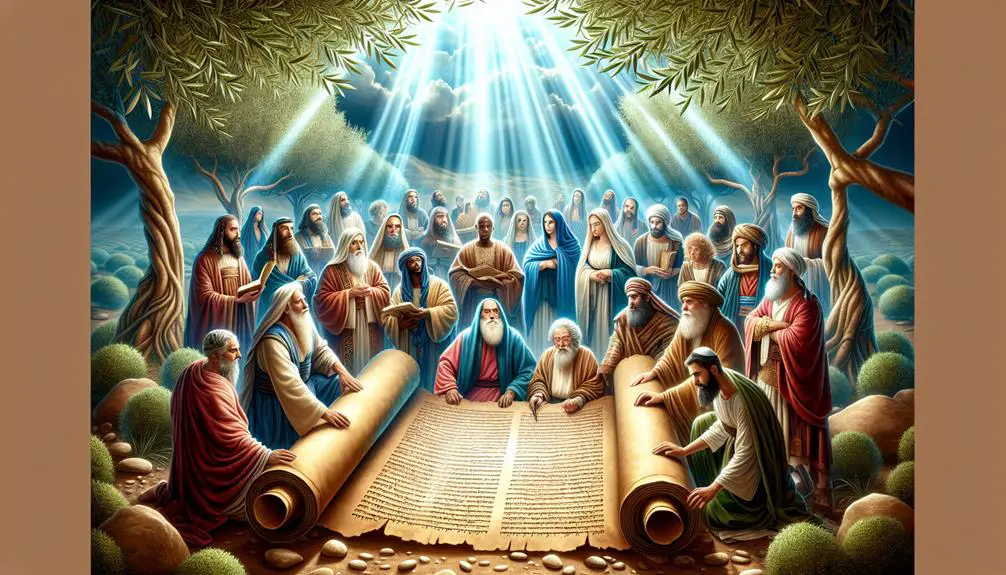
People of Color in the Bible
Consider Moses' Cushite wife, a figure who sparks curiosity about the presence and roles of people of color in the biblical narrative. You might wonder how her story, along with others like the Queen of Sheba or Simon of Cyrene, reflects the broader experiences and contributions of people of color in these ancient texts.
These characters bring a rich tapestry of cultural and ethnic diversity to the forefront, challenging common perceptions and inviting you to explore further. Their stories, often overlooked, hold keys to understanding the inclusive nature of biblical narratives, prompting questions about representation and identity that are as relevant today as they were millennia ago.
Key Takeaways
- The Bible showcases diverse characters, including Moses' Cushite wife and the Ethiopian Eunuch, highlighting racial inclusivity.
- Stories of Simon of Cyrene and the Queen of Sheba exemplify cross-cultural interactions and the global nature of biblical narratives.
- Women of color like Hagar and Rahab play pivotal roles, challenging traditional views on ethnicity and social status in sacred texts.
- Early Christianity's inclusivity is underscored by the baptism of the Ethiopian Eunuch, illustrating the faith's reach beyond cultural boundaries.
Moses' Cushite Wife
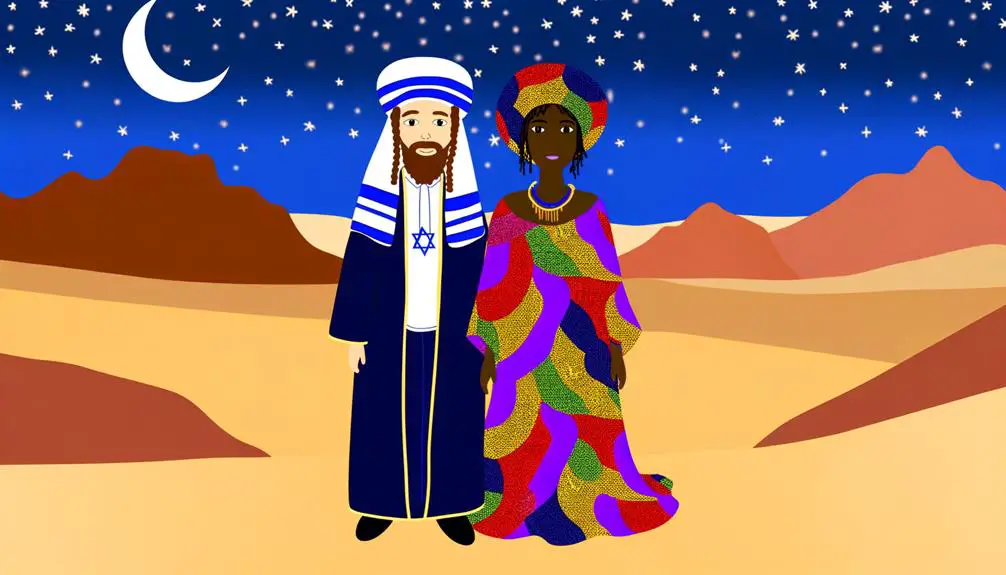
Exploring the narrative of Moses' Cushite wife opens a window into the complex interplay of race, identity, and divine purpose woven throughout biblical history. This story, though briefly mentioned in the Bible, holds significant importance as it touches upon interracial marriage at a time when such unions were often viewed through a lens of skepticism or outright rejection. You'll find that this account isn't just a footnote but a critical examination of leadership challenges that Moses faced, both within his personal life and his broader obligations.
Moses' marriage to a Cushite woman, presumably of African descent, was controversial and sparked dissent among his own siblings, Aaron and Miriam. This familial strife wasn't simply a matter of personal disagreement but underscored the broader societal tensions surrounding interracial unions. The dispute led to divine intervention, emphasizing that God's approval of Moses' leadership extended to his personal choices, including his marriage. This episode suggests a divine endorsement of interracial marriages, challenging prevailing norms and prejudices.
Moreover, Moses' leadership was put to the test, not just in guiding the Israelites through the wilderness but also in standing firm against racial prejudice within his inner circle. His response to the criticism over his marriage highlights the qualities necessary for leadership: resilience, integrity, and an unwavering commitment to divine principles over societal norms.
In analyzing Moses' Cushite wife's narrative, you're invited to reflect on the enduring themes of racial unity, the sanctity of marriage, and the challenges of leadership in the face of opposition. This story enriches our understanding of biblical history, revealing its depth and relevance to contemporary discussions on race and identity.
The Queen of Sheba
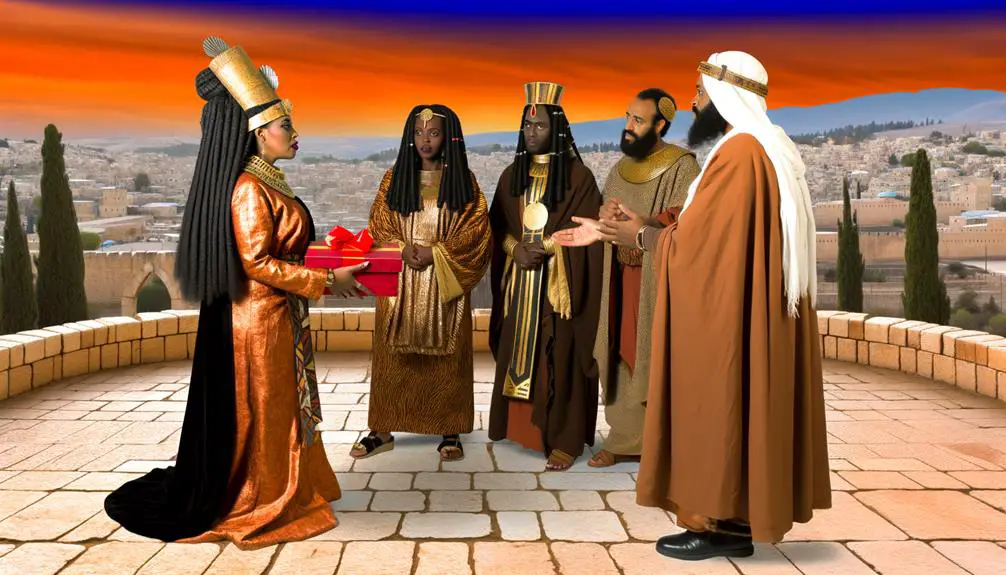
You'll find the Queen of Sheba's story fascinating, as it bridges cultures and epochs through her historic visit to King Solomon.
Her legacy, rich in interpretations, offers insight into the complex interactions between African and Middle Eastern societies in biblical times.
This narrative not only highlights her influence but also prompts a deeper understanding of the role of women of color in scriptural histories.
Her Historic Visit
The Queen of Sheba's visit to King Solomon remains a pivotal moment in biblical history, highlighting the interconnectedness of African and Middle Eastern cultures. This encounter wasn't just about the lavish gifts or the riddles they exchanged; it was a profound demonstration of cultural significance and the forging of diplomatic relations that would echo through the ages.
Aspect |
Description |
|---|---|
Cultural Exchange |
The visit bridged cultural gaps, integrating wisdom and traditions from both realms. |
Diplomatic Impact |
It laid the groundwork for future alliances, emphasizing peace and mutual respect. |
Historical Significance |
Marked a milestone in the annals of ancient diplomacy and intercultural dialogue. |
Her journey wasn't merely a footnote; it was a testament to the power of curiosity, respect, and the enduring impact of cross-cultural encounters.
Legacy and Interpretations
Throughout history, countless interpretations and legacies of the Queen of Sheba's visit to King Solomon have woven themselves into the fabric of various cultures, each adding its unique perspective and value to this ancient narrative. The story's adaptability across different cultural contexts highlights its universal appeal, yet it also presents interpretive challenges.
- Cultural Contexts: Different societies have shaped the tale to reflect their own values and traditions, enriching the story's layers and meanings.
- Interpretive Challenges: Scholars and theologians grapple with varying accounts, striving to discern historical truths amidst mythological embellishments.
- Legacy: The Queen of Sheba's story continues to inspire art, literature, and discourse, proving its enduring relevance and power to captivate imaginations across generations and geographies.
Simon of Cyrene
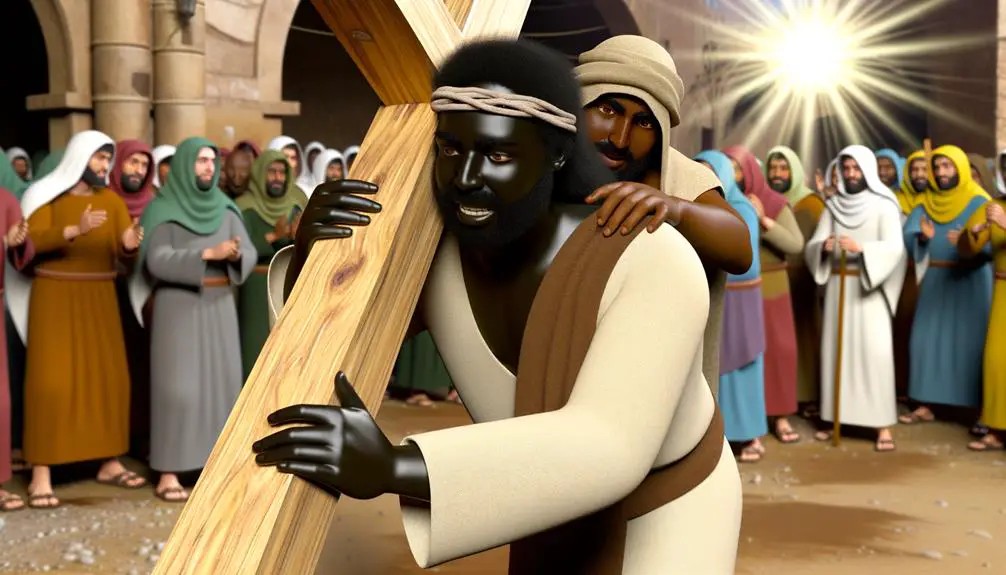
As you explore the representation of people of color in the Bible, it's essential to consider Simon of Cyrene, whose ethnic background and role in the crucifixion event offer valuable insights.
Cyrene, located in modern-day Libya, suggests that Simon was likely of African descent.
His compelled assistance in carrying the cross for Jesus not only highlights his significant, albeit brief, role in a pivotal moment but also invites reflection on the broader implications of racial and geographical diversity in biblical narratives.
Simon's Ethnic Background
Often overlooked, Simon of Cyrene's ethnic background provides valuable insight into the diverse tapestry of individuals portrayed in the Bible. Cyrene, located in modern-day Libya, was a place of significant Roman influence and cultural diversity. This context is crucial for understanding Simon's heritage.
- Roman Influence: Cyrene was a prominent city within the Roman Empire, suggesting Simon was familiar with Roman customs and possibly multilingual.
- Cyrene's Significance: As a hub of learning and commerce, Cyrene's residents, including Simon, likely had interactions with a variety of cultures and ideologies.
- Ethnic Diversity: Simon's background underscores the ethnically diverse nature of biblical narratives, challenging narrow interpretations of the Bible's cultural context.
Recognizing Simon's ethnic background enriches our understanding of the historical and cultural complexities within biblical stories.
Role in Crucifixion Event
Carrying the cross of Jesus, Simon of Cyrene's involvement in the crucifixion event highlights a moment of profound intersection between human suffering and divine narrative. You see, his role isn't just a random act; it's charged with symbolism and meaning. This episode underlines not only Roman involvement but also the complex dynamics with Jewish leaders during this pivotal moment in history.
Aspect |
Detail |
Significance |
|---|---|---|
Roman Involvement |
Forced Simon's participation |
Displays power dynamics |
Jewish Leaders |
Complicit in crucifixion |
Complex religious-political landscape |
Simon's Role |
Carried the cross |
Human-divine narrative intersection |
Symbolism |
Shared suffering |
Universal theme of empathy |
Simon's act, coerced by Roman soldiers yet deeply entwined with the fate of Jesus, reflects a broader narrative of power, resistance, and compassion.
The Ethiopian Eunuch
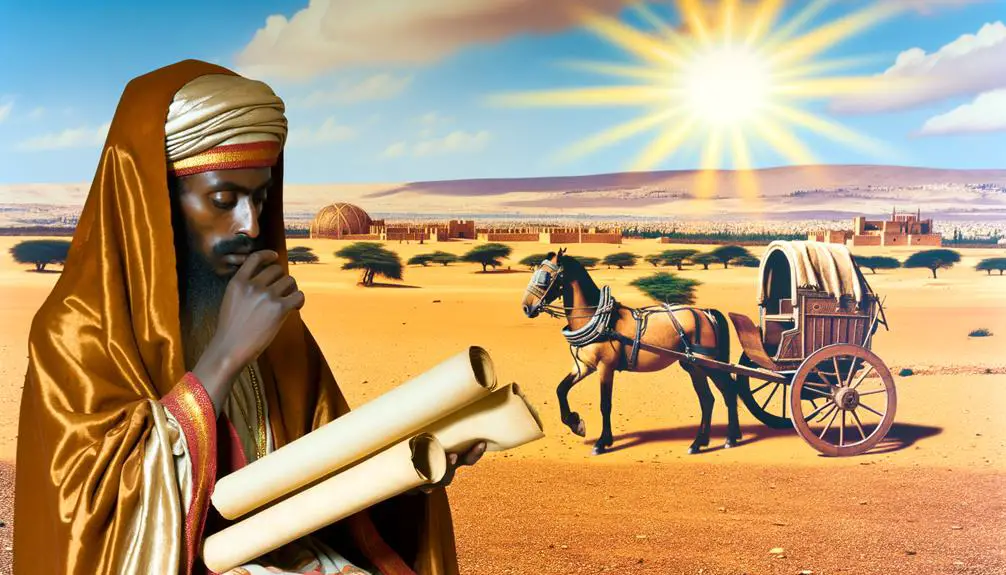
In the Acts of the Apostles, you'll find the story of the Ethiopian Eunuch, a figure who represents early African involvement in Christianity. This account not only highlights the geographical and ethnic diversity present in the early Christian movement but also underscores the inclusivity of the Christian message. The Ethiopian Eunuch's encounter with Philip, one of the early Christians, leads to his conversion and baptism, marking a significant moment in the spread of Christianity into Africa.
The narrative of the Ethiopian Eunuch is pivotal for several reasons:
- Ethiopian Christianity: It's one of the earliest instances documenting the spread of Christianity to Africa, suggesting that Ethiopian Christianity has roots that go back to the very inception of the religion. This challenges the perception that Christianity in Africa was solely a result of European missionary efforts in the modern era.
- Baptism Significance: The baptism of the Ethiopian Eunuch by Philip signifies the openness and accessibility of the Christian faith to all, regardless of ethnicity or social status. This act of baptism is a profound demonstration of the transformative power of faith and acceptance within the Christian tradition.
- Cultural Intersection: The story exemplifies an early instance of cross-cultural interaction within the Christian faith. It showcases how the message of Christianity transcended geographical, cultural, and racial boundaries to include a diverse array of believers.
Analyzing the Ethiopian Eunuch's story, you gain insights into the inclusive nature of early Christianity, the significance of baptism as a rite of initiation and belonging, and the early roots of Ethiopian Christianity. This account is a testament to the far-reaching impact and diversity of the Christian faith.
Hagar, Egyptian Handmaid

CURRENT SUBTOPIC: 'Hagar, Egyptian Handmaid'
Another significant figure representing diversity in the Bible is Hagar, the Egyptian handmaid, whose story offers profound insights into themes of faith, resilience, and divine intervention. Serving as Sarah's handmaid, Hagar's journey from a position of subjugation to one where she directly interacts with the divine reveals much about her resilience and the complexity of her cultural identity.
Hagar's resilience shines through when she flees into the desert, facing uncertainty rather than enduring mistreatment. It's here, in her most vulnerable state, that she encounters an angel of God, showcasing divine intervention not just in her life but affirming her significance within the biblical narrative. This encounter emphasizes her worth and the importance of her offspring, directly challenging any notions of insignificance due to her status or ethnicity.
Hagar's cultural identity plays a crucial role in understanding the broader context of her story. As an Egyptian, she represents a bridge between different worlds and peoples within the biblical narrative, highlighting the interconnectedness of various cultures and their impact on the unfolding biblical story.
Aspect |
Explanation |
|---|---|
Cultural Identity |
Hagar, an Egyptian, adds a layer of cultural diversity, representing a confluence of cultures within the biblical narrative. |
Resilience |
Despite adversity, Hagar's strength and faith lead to divine encounters, underscoring her indomitable spirit. |
Divine Intervention |
Her personal interactions with God highlight her importance and challenge societal norms about status and race. |
Legacy |
Through her son Ishmael, Hagar contributes to the foundation of nations, underlining her pivotal role in biblical history. |
Representation |
Hagar stands as a testament to the presence and influence of women of color in sacred texts. |
Hagar's story isn't just a testament to her own strength; it's a reflection on the broader themes of faith, identity, and divine grace in the face of adversity.
Balthazar, A Magus
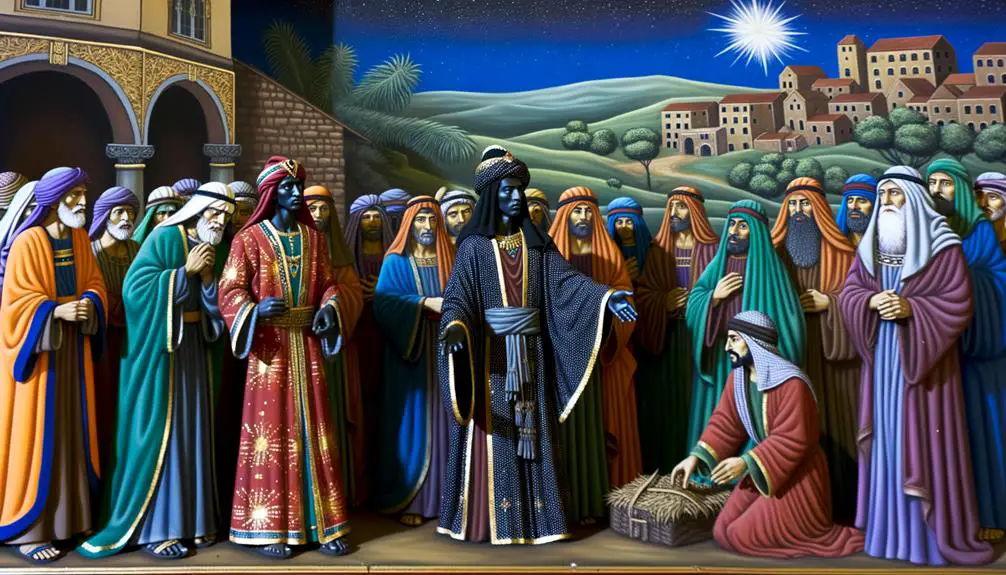
Among the revered figures in the biblical narrative, Balthazar, a Magus, stands out for his journey of faith and wisdom that transcends geographical and cultural boundaries. His story, deeply embedded in Christian tradition, offers a window into the rich tapestry of individuals who played pivotal roles in biblical events. Balthazar's tale is especially notable for the insights it provides into the diversity present within the scriptural accounts.
Balthazar's significance can be enlightened through several key aspects:
- Magus Origin: Balthazar, along with the other Magi, hailed from regions that are now understood to be parts of ancient Persia or perhaps even farther east. This origin points to the inclusive nature of the biblical narrative, highlighting figures from a variety of racial and ethnic backgrounds. The term 'Magus' itself denotes a practitioner of Zoroastrianism, a religion rich in astrological and magical traditions, which further accentuates the cross-cultural interactions that are a hallmark of these ancient stories.
- Star Interpretation: The Magi's journey to Bethlehem, prompted by their interpretation of a celestial event as signaling the birth of a new king, showcases the blend of faith and scholarship. Their understanding of the stars led them across vast distances, illustrating the universal search for truth and enlightenment.
- Cultural Exchange: The gifts the Magi offered—gold, frankincense, and myrrh—were not only symbolic but also represented the exchange of goods and ideas across cultures. Balthazar's participation in this event underscores the interconnectedness of the ancient world.
Balthazar's story invites you to appreciate the diversity and richness of the characters within the Bible, highlighting that wisdom, faith, and revelation know no boundaries.
Rahab of Jericho
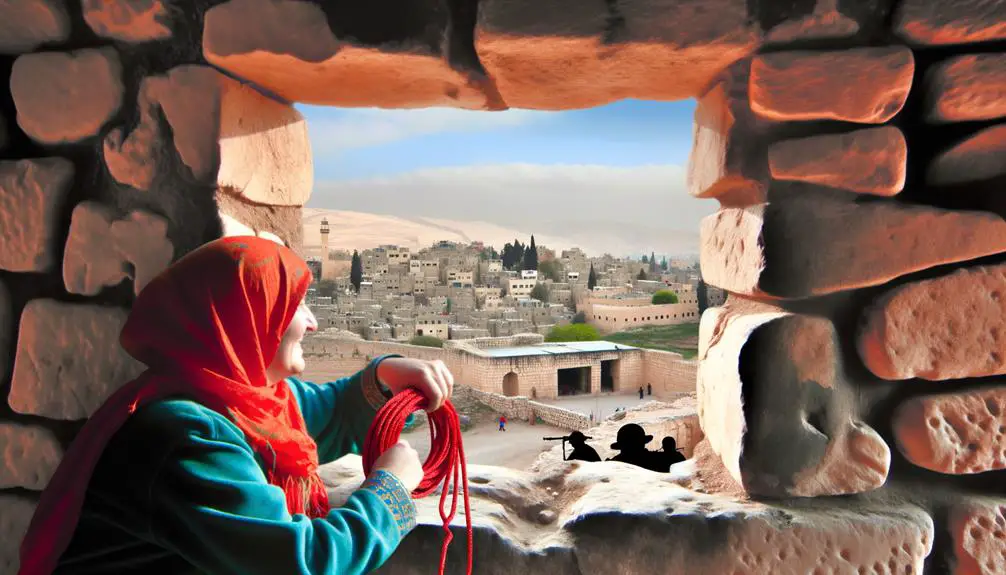
Rahab of Jericho, a figure whose story unfolds within the walls of a city destined for destruction, demonstrates the profound impact of faith and courage across cultural and ethical boundaries. Her actions, sheltering Israelite spies, speak to a broader narrative of redemption and inclusivity within a context often marred by division.
Jericho's significance in biblical history cannot be understated, serving as the first major conquest of the Israelites in their quest for the Promised Land. Archaeological evidence corroborates the city's existence and its walls' collapse, adding a layer of historical authenticity to Rahab's story. Her faith, despite being an outsider, challenges and expands our understanding of the divine's reach and mercy.
Aspect |
Significance |
|---|---|
Jericho's Walls |
Symbolize barriers, both physical and ideological, that faith can overcome. |
Rahab's Faith |
Demonstrates a universal potential for redemption, regardless of one's past or ethnicity. |
Archaeological Evidence |
Lends credibility to the narrative, bridging faith and historical inquiry. |
Cultural Integration |
Rahab's integration into Israelite society underscores themes of inclusivity and diversity. |
Ethical Boundaries |
Her story invites reflection on the ethics of loyalty, betrayal, and the greater good. |
Rahab's narrative is not just a testament to her personal bravery but a reflection on the complexities of faith, identity, and the walls we build around ourselves and others. Her story, deeply entwined with Jericho's significance and supported by archaeological evidence, remains a powerful reminder of the potential for transformation and unity amidst diversity.
The Shunammite Woman

Just as Rahab's story highlights the impact of faith and courage from an outsider's perspective, the narrative of the Shunammite woman offers a compelling exploration of hospitality, faithfulness, and womanhood within biblical lore. When you delve into her story, you'll find it's not just about her social status or her interactions with Elisha; it's a powerful testament to the multi-faceted roles women play in their communities and in the broader context of biblical history.
Here are three key aspects to consider about the Shunammite woman:
- Hospitality as a Virtue: She's renowned for her unwavering hospitality towards Elisha, demonstrating a profound sense of generosity and kindness. This wasn't a mere act of social obligation given her status but a genuine expression of her character.
- Faithfulness in Trials: Her story is punctuated by one of Elisha's miracles—the resurrection of her son. This miracle not only underscores the power of prophetic intervention but also her immense faith. Amid unimaginable grief and despair, her unwavering belief in Elisha's godly power stands out, showcasing her resilience and depth of faith.
- Social Status and Influence: While her social status afforded her certain privileges, it's her moral and spiritual stature that truly defines her. Her interactions with Elisha bring to light the influence she wielded, not through wealth or position, but through her actions and faith.
In analyzing the Shunammite woman's story, you're invited to reflect on the themes of hospitality, faithfulness, and the nuanced portrayal of womanhood, enriching your understanding of biblical narratives and their relevance today.
Frequently Asked Questions
How Has the Interpretation of Racial Identities in the Bible Evolved Over Time in Various Christian Denominations?
You'll find that the interpretation of racial identities in the Bible has shifted significantly across Christian denominations due to evolving church demographics and theological narratives.
Initially, many denominations didn't focus on race. However, as awareness of diversity and inclusivity grew, interpretations began to change.
Now, scholars and believers alike delve deeper into the Bible's texts to understand and appreciate the rich tapestry of racial identities presented, fostering a more inclusive faith community.
What Role Do Archaeological Findings Play in Understanding the Racial and Ethnic Backgrounds of Biblical Figures?
You're diving into how archaeological findings, including genetic research and artifact dating, clarify the racial and ethnic backgrounds of biblical figures. These tools offer concrete evidence, moving beyond speculation.
Genetic research unpacks ancestry, revealing diverse origins, while artifact dating contextualizes these figures within specific historical and geographical settings. Together, they provide a more nuanced understanding, challenging simplistic interpretations and enriching your grasp of biblical narratives.
How Have Depictions of People of Color in Biblical Artworks Influenced Contemporary Views of Race and Ethnicity in Religious Contexts?
Depictions in biblical artworks act like mirrors, reflecting and shaping contemporary views on race and ethnicity. They've often missed the mark on artistic accuracy and cultural representation, leading to a skewed understanding.
You're seeing history through a distorted lens, where the diversity of ancient communities isn't accurately portrayed. This influences how you perceive racial and ethnic identities in religious contexts today, underscoring the need for a more informed and respectful approach to cultural depiction.
In What Ways Have Modern Scholars Critiqued Traditional Eurocentric Interpretations of the Bible's Racial and Ethnic Diversity?
Modern scholars critique traditional Eurocentric Bible interpretations by highlighting cultural bias and questioning interpretation methodologies. They argue that earlier readings often ignored the Bible's diverse racial and ethnic landscape, offering a narrow perspective.
You'll find that their work pushes for a broader understanding, urging a reexamination of biblical figures and stories through a lens that accounts for historical and cultural complexities. This approach seeks to enrich religious and scholarly discussions with a more inclusive narrative.
How Do Linguistic Studies Contribute to Our Understanding of the Racial Identities of People Mentioned in the Bible?
Linguistic studies shed light on the Bible's racial identities by analyzing language evolution and scriptural semantics.
You'll find that these analyses offer insights into how terms and descriptions of people have changed over time, revealing the diverse backgrounds of biblical figures.
This approach helps you understand the historical context better and challenges traditional interpretations.
Conclusion
You've journeyed through the lives of remarkable figures, from Moses' Cushite wife to the wisdom of the Queen of Sheba, and the pivotal roles of Simon of Cyrene, the Ethiopian Eunuch, and others.
These narratives juxtapose the rich diversity of the ancient world with modern perceptions, challenging us to reevaluate our understanding of biblical history.
Their stories, steeped in cultural and racial diversity, offer a profound insight into the inclusive nature of divine narratives, inviting us to embrace a broader perspective.

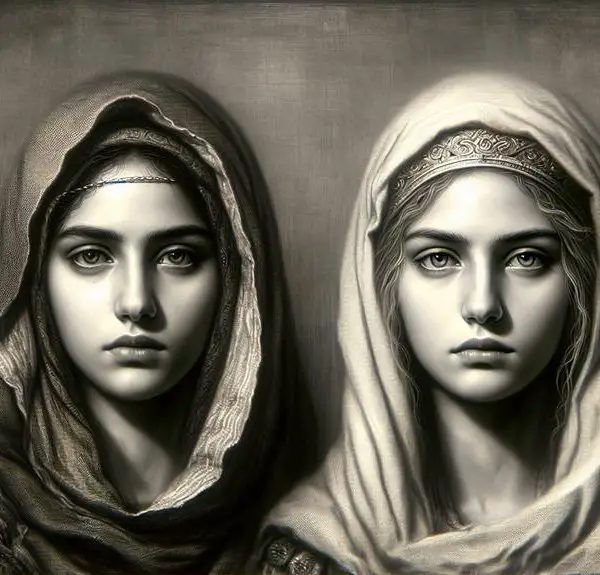
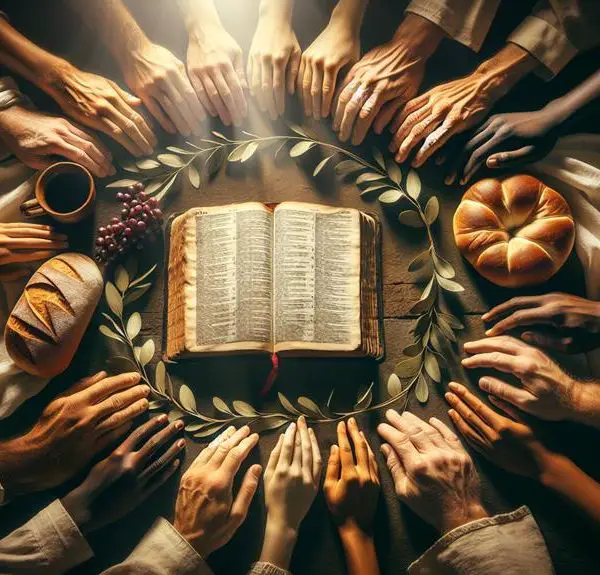
Sign up